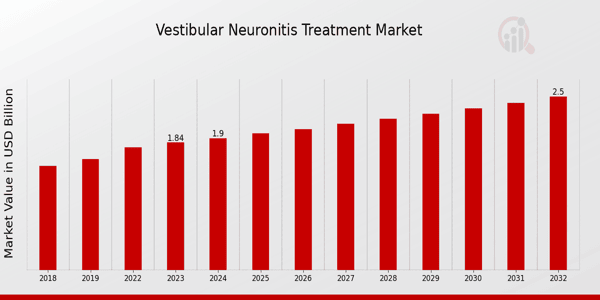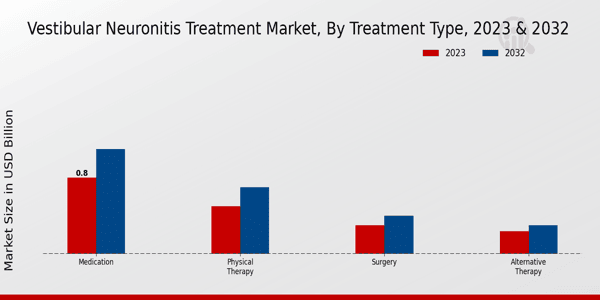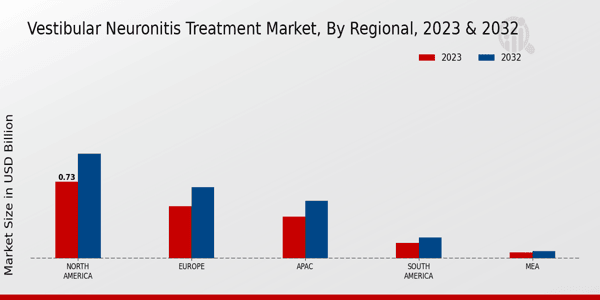Vestibular Neuronitis Treatment Market Overview
As per MRFR analysis, the Vestibular Neuronitis Treatment Market Size was estimated at 1.96 (USD Billion) in 2024. The Vestibular Neuronitis Treatment Market Industry is expected to grow from 2.03 (USD Billion) in 2025 to 2.77 (USD Billion) till 2034, at a CAGR (growth rate) is expected to be around 3.49% during the forecast period (2025 - 2034).
Key Vestibular Neuronitis Treatment Market Trends Highlighted
The Vestibular Neuronitis Treatment Market is influenced by several key drivers that shape its growth trajectory. An increasing prevalence of vestibular disorders, primarily due to rising cases of viral infections, has heightened the demand for effective treatments. Moreover, growth in awareness regarding vestibular disorders and the importance of timely diagnoses and interventions further propels market expansion. Improved healthcare infrastructure and advancements in medical technology also play crucial roles in enhancing treatment options, leading to better patient outcomes and increasing acceptance of novel therapies in clinical settings.
The market prospects are huge, especially with ongoing research into new ways of treatment. The focus seems to be on the development of more efficient and focused therapies, which creates an opportunity for both new entrants as well as existing players to gain market share. The scope for personalized medicine in the management of vestibular disorders also presents an opportunity since the treatment will be targeted to patients’ needs. In addition, cooperation among academic institutions and pharmaceutical companies may speed up the process of putting new drugs and therapies on the market, which is advantageous for growth.
Recent events show a movement towards a more tailored approach to patients where their needs are the driving force for the treatment plan. There is also an increasing trend of patients using telemedicine for consultations and follow-ups, thus allowing patients to interact with specialists regardless of distance. The implementation of new technologies and digital healthcare approaches has been incorporated into the treatment process, making healthcare more beneficial. As the market develops, the need for comprehensive management of vestibular disorders including their psychological impacts, is also increasing.
This change embodies a more nuanced comprehension of the illness, which, in the end, enhances both the patient’s quality of life and treatment options.

Source: Primary Research, Secondary Research, MRFR Database and Analyst Review
Vestibular Neuronitis Treatment Market Drivers
Increasing Prevalence of Vestibular Disorders
The rising incidence of vestibular disorders, including vestibular neuronitis, is a substantial driver for the Vestibular Neuronitis Treatment Market Industry. As the population ages, the prevalence of these disorders is likely to increase significantly. Aging is a critical risk factor for vestibular neuronitis, as older individuals may experience a decline in their vestibular function due to various health conditions. Furthermore, environmental factors, lifestyle changes, and a more sedentary lifestyle contribute to the growing number of people experiencing vestibular issues.
Increased awareness and diagnosis of vestibular disorders have led to a higher number of patients seeking treatment, thereby fueling market growth. The medical community is increasingly recognizing the importance of addressing vestibular disorders comprehensively, which drives research and development efforts geared toward new therapeutic options. Consequently, the demand for effective treatments is on the rise, benefiting pharmaceutical companies and healthcare providers focused on the Vestibular Neuronitis Treatment Market Industry.
This expanding patient base creates a robust environment for existing treatment modalities and innovations, ensuring sustained market growth in the foreseeable future.
Advancements in Treatment Options
Continuous innovations in treatment options for vestibular neuronitis significantly enhance the growth trajectory of the Vestibular Neuronitis Treatment Market Industry. New medications, physical therapy techniques, and alternative therapies provide a broader range of solutions to cater to varying patient needs. Advances in clinical research contribute to a better understanding of the pathophysiology of vestibular neuronitis, leading to improved treatment protocols.
Healthcare professionals are now better equipped to manage this condition, which in turn attracts more patients seeking effective management strategies. As treatment modalities evolve, patients benefit from a higher quality of care, thus expanding the market further.
Rising Healthcare Expenditure
The increasing healthcare expenditure globally is a significant driver for the Vestibular Neuronitis Treatment Market Industry. With governments and private sectors investing more in healthcare infrastructure and services, patients have greater access to treatments for vestibular disorders. This increase in healthcare spending enables the development of advanced treatment facilities and more comprehensive healthcare programs that cater to vestibular disease management.
As patients have more financial resources for treatment options, there is a corresponding rise in demand for effective and timely interventions, consequently propelling the market growth for vestibular neuronitis therapies.
Vestibular Neuronitis Treatment Market Segment Insights:
Vestibular Neuronitis Treatment Market Treatment Type Insights
The Vestibular Neuronitis Treatment Market is expanding, with Treatment Type serving as a crucial segment encompassing various approaches. In 2023, the market stands at a valuation of 1.84 USD Billion, projected to grow to 2.5 USD Billion by 2032, demonstrating the vital role of effective treatment options. Among the distinct Treatment Type segments, Medication dominates, holding a substantial value of 0.8 USD Billion in 2023 and advancing to 1.1 USD Billion by 2032. Its significant growth reflects the high demand for pharmaceutical interventions in managing vestibular neuronitis, which often involves symptoms such as vertigo and imbalance.
Physical Therapy, valued at 0.5 USD Billion in 2023 and expected to reach 0.7 USD Billion by 2032, remains an essential component, offering rehabilitation strategies that aid in improving balance and reducing dizziness in affected individuals. Surgery, while the smallest segment, still holds relevance with a valuation of 0.3 USD Billion in 2023, projected to increase to 0.4 USD Billion by 2032; it emphasizes the necessity for surgical options in specific, severe cases of vestibular disorders. Alternative Therapy, valued at 0.24 USD Billion in 2023, is anticipated to grow to 0.3 USD Billion by 2032, indicating a growing interest among patients for holistic and non-invasive treatment options.
The varied approaches within the Vestibular Neuronitis Treatment Market reveal the diverse patient needs and the potential for innovation in treatment methodologies. Market growth is largely driven by an increasing understanding of vestibular disorders, advancements in treatment options, and heightened awareness of available interventions, all of which contribute to expanding choices for individuals suffering from vestibular neuronitis. However, challenges such as healthcare access limitations and varying treatment efficacy across different demographics warrant attention.Together, these insights underscore the dynamic landscape of the Vestibular Neuronitis Treatment Market, highlighting medication as a major player, while physical therapy provides essential support, and both surgery and alternative therapy complement the broader treatment paradigm.

Source: Primary Research, Secondary Research, MRFR Database and Analyst Review
Vestibular Neuronitis Treatment Market Route of Administration Insights
The Vestibular Neuronitis Treatment Market, valued at approximately 1.84 USD Billion in 2023, showcases diverse avenues of administration impacting treatment efficacy and patient preferences significantly. The Route of Administration segment is crucial as it aligns therapeutic solutions to patient needs, promoting better compliance and outcomes. Among the various modes, oral administration typically garners favorable attention due to its convenience and ease of use, making it accessible for long-term management. Intravenous administration plays a pivotal role, particularly in acute cases, ensuring rapid onset of action, which is essential for symptomatic relief.
Intramuscular administration also holds importance, especially in scenarios where oral delivery is not feasible, offering an alternative route with efficient drug absorption. The increasing prevalence of vestibular neuronitis necessitates diversified treatment approaches, encouraging innovation in drug delivery methods. Overall, the Vestibular Neuronitis Treatment Market segmentation illustrates the importance of tailored routes of administration and their influence on therapeutic effectiveness and patient adherence. Market data and statistics further underscore the trends and opportunities in optimizing routes, reflecting an evolving industry landscape.
Vestibular Neuronitis Treatment Market Age Group Insights
The Vestibular Neuronitis Treatment Market, valued at approximately 1.84 billion USD in 2023, showcases diverse opportunities driven by different age groups, including Children, Adults, and the Elderly. Each age group has unique treatment needs and response profiles, with the adult demographic representing a significant portion of the market, as they are often diagnosed with vestibular disorders due to lifestyle factors and increased stress levels. On the other hand, Children require targeted therapeutic approaches that address developmental issues related to balance and coordination affected by vestibular neuronitis.
The Elderly population tends to dominate the market as well, given their increased susceptibility to vestibular disorders due to age-related decline in health, making tailored treatments essential for their well-being. The ongoing development of advanced treatment options and increasing awareness of vestibular disorders are key growth drivers in this segment. However, challenges such as accessibility to treatments and variability in treatment responses among different age groups continue to persist, presenting both hurdles and opportunities for growth within the industry.
The Vestibular Neuronitis Treatment Market statistics reflect these dynamics, paving the way for focused innovations and market expansion catering to all age segments.
Vestibular Neuronitis Treatment Market Diagnosis Type Insights
The Vestibular Neuronitis Treatment Market is projected to be valued at 1.84 billion USD in 2023, demonstrating the importance of understanding the Diagnosis Type segment. This market is segmented into various categories, such as Clinical Diagnosis, Imaging Diagnosis, and Vestibular Function Tests, each contributing to the overall assessment and management of vestibular neuronitis. Clinical Diagnosis typically plays a crucial role due to its emphasis on patient history and physical examinations, enabling healthcare providers to identify symptoms effectively.
Imaging Diagnosis also holds significant importance as it assists in ruling out other conditions through advanced imaging techniques. Meanwhile, Vestibular Function Tests are essential diagnostic tools that evaluate the integrity of the vestibular system, thus contributing greatly to accurate diagnosis and treatment planning. Together, these categories encompass key components of the diagnostic process, which is pivotal for enhancing patient outcomes in the Vestibular Neuronitis Treatment Market. As the market evolves, growth drivers, such as the increasing prevalence of vestibular disorders and advancements in diagnostic technology, continue to shape the landscape, presenting both opportunities and challenges to stakeholders involved in this sector.
Vestibular Neuronitis Treatment Market Regional Insights
The Vestibular Neuronitis Treatment Market is significantly influenced by its regional distribution, with North America leading the way in market value. In 2023, North America is valued at 0.73 USD Billion and is projected to grow to 1.0 USD Billion by 2032, showcasing its dominance and majority holding in the market. Europe follows with a valuation of 0.5 USD Billion in 2023, growing to 0.68 USD Billion by 2032 and displaying its significant role in treatment advancements. The Asia-Pacific region, valued at 0.4 USD Billion in 2023, is expected to increase to 0.55 USD Billion, highlighting its emerging importance due to a growing healthcare focus and patient awareness.
South America and the Middle East Africa are valued at 0.15 USD Billion and 0.06 USD Billion in 2023, respectively, with projected incremental growth to 0.2 USD Billion and 0.07 USD Billion by 2032, reflecting their niche presence in the market. The regional segmentation reveals vital growth drivers, such as increasing incidences of vestibular disorders and rising healthcare expenditure, while challenges include varying healthcare infrastructures and limited awareness in some regions. Furthermore, the Vestibular Neuronitis Treatment Market data shows promising opportunities for innovative treatments and therapies across these regions, underscoring the potential for market expansion.

Source: Primary Research, Secondary Research, MRFR Database and Analyst Review
Vestibular Neuronitis Treatment Market Key Players and Competitive Insights:
The Vestibular Neuronitis Treatment Market is characterized by a growing demand for effective therapeutic solutions that cater to patients experiencing this neurological condition. Competitive insights in this market reveal a dynamic landscape where various pharmaceutical companies are actively engaging in research and development to enhance treatment options. Increasing awareness of vestibular disorders and the necessity for timely interventions further contribute to the market's expansion. Key players are focused on developing innovative drug formulations and techniques to optimize patient outcomes. Collaboration among stakeholders, including healthcare providers and research institutions, is also fostering advancements in treatment protocols and patient care strategies. As the market evolves, the importance of strategic partnerships and competitive differentiation is becoming increasingly evident.
Sanofi holds a significant presence in the Vestibular Neuronitis Treatment Market, leveraging its extensive experience in the pharmaceutical industry. The company's robust portfolio includes a range of products that effectively address vestibular disorders, supported by a strong emphasis on research and development activities. Sanofi's established distribution channels and relationships with healthcare professionals strengthen its market position, enabling the company to reach a broader patient demographic. Additionally, its commitment to patient-centric initiatives and collaborations with medical organizations plays a crucial role in enhancing treatment awareness and accessibility. With ongoing efforts to innovate and broaden its therapeutic offerings, Sanofi continues to be a formidable competitor in this specialized market.
Merck is another key player in the Vestibular Neuronitis Treatment Market, recognized for its commitment to addressing complex neurological conditions. The company's approach often involves an extensive pipeline of research initiatives that aim to bring forth new and effective treatment options. Merck's strengths lie in its well-established scientific expertise and a strong network of healthcare partnerships that facilitate the delivery of treatments to patients. By prioritizing evidence-based practices and clinical initiatives, Merck significantly contributes to advancing treatment methodologies for vestibular neuronitis. Its ability to adapt to emerging market needs, coupled with a solid reputation in pharmaceutical innovation, positions Merck favorably within this competitive landscape, allowing it to effectively serve patients with vestibular disorders.
Key Companies in the Vestibular Neuronitis Treatment Market Include:
- Sanofi
- Merck
- Johnson and Johnson
- Eli Lilly
- GlaxoSmithKline
- Gilead Sciences
- Novartis
- AstraZeneca
- Amgen
- AbbVie
- Biogen
- BristolMyers Squibb
- Teva Pharmaceuticals
- Roche
- Pfizer
Vestibular Neuronitis Treatment Market Industry Developments
The Vestibular Neuronitis Treatment Market has witnessed significant developments, particularly with advancements in drug therapies and increased research funding. Companies like Pfizer and Johnson Johnson are actively investing in clinical trials to explore innovative treatment options, targeting both short-term relief and long-term management of symptoms related to this condition. Sanofi recently announced a new partnership aimed at developing a combination therapy that could enhance patient outcomes in vestibular disorders. Meanwhile, Eli Lilly has made headlines with plans to expand its research portfolio in neurotology, focusing on vestibular disorders, which is expected to create more treatment avenues.
In terms of mergers and acquisitions, there have been discussions around AstraZeneca acquiring smaller biotechnological firms specializing in vestibular conditions to bolster its pipeline. The market valuation of these companies has shown a positive upward trend, stimulated by heightened demand for effective treatments and a growing patient population. The overall encouraging growth and robust investment landscape indicate a promising future for the Vestibular Neuronitis Treatment Market, with several key players actively contributing to advancements in treatment modalities.
Vestibular Neuronitis Treatment Market Segmentation Insights
- Vestibular Neuronitis Treatment Market Treatment Type Outlook
- Medication
- Physical Therapy
- Surgery
- Alternative Therapy
- Vestibular Neuronitis Treatment Market Route of Administration Outlook
- Oral
- Intravenous
- Intramuscular
- Vestibular Neuronitis Treatment Market Age Group Outlook
- Vestibular Neuronitis Treatment Market Diagnosis Type Outlook
- Clinical Diagnosis
- Imaging Diagnosis
- Vestibular Function Tests
- Vestibular Neuronitis Treatment Market Regional Outlook
- North America
- Europe
- South America
- Asia Pacific
- Middle East and Africa
| Report Attribute/Metric |
Details |
|
Market Size 2024
|
1.96 (USD Billion)
|
|
Market Size 2025
|
2.03 (USD Billion)
|
|
Market Size 2034
|
2.77 (USD Billion)
|
|
Compound Annual Growth Rate (CAGR)
|
3.49 % (2025 - 2034)
|
|
Report Coverage
|
Revenue Forecast, Competitive Landscape, Growth Factors, and Trends
|
|
Base Year
|
2024
|
|
Market Forecast Period
|
2025 - 2034
|
|
Historical Data
|
2020 - 2024
|
| Market Forecast Units |
USD Billion |
| Key Companies Profiled |
Sanofi, Merck, Johnson and Johnson, Eli Lilly, GlaxoSmithKline, Gilead Sciences, Novartis, AstraZeneca, Amgen, AbbVie, Biogen, BristolMyers Squibb, Teva Pharmaceuticals, Roche, Pfizer |
| Segments Covered |
Treatment Type, Route of Administration, Age Group, Diagnosis Type, Regional |
| Key Market Opportunities |
Increasing prevalence of vestibular disorders, Advancement in treatment technologies, Rising awareness and education initiatives, Growing demand for tailored therapies, Expanding healthcare access in emerging regions |
| Key Market Dynamics |
Rising prevalence of vertigo disorders, Growing demand for advanced treatment options, Increasing awareness about vestibular disorders, Development of targeted therapies, Strong pipeline of new drugs |
| Countries Covered |
North America, Europe, APAC, South America, MEA |
Frequently Asked Questions (FAQ) :
The Vestibular Neuronitis Treatment Market is expected to reach a valuation of 2.5 USD Billion by 2034.
The expected CAGR for the Vestibular Neuronitis Treatment Market is 3.49% during the forecast period from 2025 to 2034.
North America is projected to dominate with a market size of 1.0 USD Billion in 2034.
The market size for medication as a treatment type is anticipated to reach 1.1 USD Billion in 2034.
Major players include Sanofi, Merck, Johnson and Johnson, and Eli Lilly, among others.
The physical therapy market size is expected to grow to 0.7 USD Billion by 2034.
The surgery treatment segment is projected to be valued at 0.4 USD Billion in 2034.
The APAC region is expected to reach a market value of 0.55 USD Billion in 2032.
The alternative therapy segment is expected to be valued at 0.3 USD Billion in 2034.
South America is expected to reach 0.2 USD Billion, while MEA is projected to be 0.07 USD Billion in 2032.

















